What is penile cancer?
Penile cancer starts in or on the penis. It most commonly starts in the skin cells of the penis. A cancerous (malignant) tumour is a group of cancer cells that can grow into and destroy nearby tissue. It can also spread (metastasize) to other parts of the body.
Cells in the penis sometimes change and no longer grow or behave normally. These changes may lead to non-cancerous (benign) conditions such as genital warts (also called condylomata).
Changes to cells of the penis can also cause precancerous conditions. This means that the abnormal cells are not yet cancer, but there is a chance that they may become cancer if they aren’t treated. The most common precancerous condition of the penis is penile intraepithelial neoplasia (PeIN).
But in some cases, changes to cells of the penis can cause cancer. Most often, penile cancer starts in flat, thin cells called squamous cells. These cells are in the skin of the penis and the head of the penis (called the glans). This type of cancer is called squamous cell carcinoma (SCC) of the penis. SCC can develop anywhere on the penis, but it develops most often on the foreskin (in uncircumcised men) or the glans.
Rare types of penile cancer can also develop. These include adenocarcinoma, melanoma and basal cell carcinoma (BCC).
The penis is part of the male reproductive system and urinary system. The main structures of the male reproductive system are the testicles, epididymis, seminal vesicles, prostate and penis. The internal parts of the male reproductive system are located in the lower pelvic cavity between the hip bones. The penis hangs in front of the pouch of skin (scrotum) that contains the testicles.

Structure
The penis is made of different types of tissue, including skin, nerves, smooth muscle and blood vessels.
The shaft is the main part of the penis. The head of the penis is called the glans. The glans is covered by a loose fold of moveable skin called the foreskin (prepuce). Sometimes the foreskin is surgically removed in an operation called a circumcision. The base of the penis within the pelvis is called the root.
The penis is made up of 3 chambers of spongy tissue containing many blood vessels:
- The corpora cavernosa (singular: corpus cavernosum) are the 2 upper chambers of the shaft that make up most of the penis.
- The corpus spongiosum is the lower chamber of the shaft that surrounds the urethra.
Inside the penis is a thin tube called the urethra. The urethra extends from the base of the bladder to the tip of the penis. The opening of the urethra in the glans of the penis is called the meatus. Urine and semen travel through the urethra and leave the body through the meatus.

Function
The penis is part of the urinary system. It contains the urethra, which carries urine from the bladder to the outside of the body.
The penis is also a male sex organ. During an erection, nerves signal the blood vessels
inside the corpora cavernosa of the penis to fill with blood. When the blood flow
increases, the spongy tissue expands and causes the penis to stiffen and enlarge. This
allows the penis to be inserted into the vagina during sexual intercourse.
